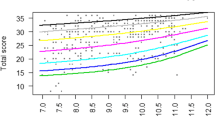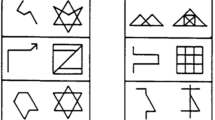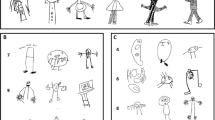Abstract
We evaluated the copying abilities of ten subjects with Williams syndrome (WS; age 6–14 years) and ten normally developing children (age 3–6 years) matched for mental age using the matrices component of the Kaufman Brief Intelligence Test (mKBIT). Each subject copied six figures, including line drawings of closed and open geometrical shapes (alone and in combination), crossed lines, and geometrical shapes made of distinct small, filled circles. Qualitatively, subjects of both groups made comparable copies, although several subjects with WS drew a continuous line when copying figures composed of distinct circles. Quantitatively, the goodness of the copies was assessed by three human observers who rated on an analog scale the similarity of each copy to its visual template. Ratings were converted to a scale from zero (completely different) to 100 (the same) for statistical analyses. We found the following. First, the overall goodness of copies of the templates was very similar between the WS and control groups (WS: mean=46.7, range=0.89–95.4; control: mean=54.5, range=0.89–98.2). Second, there were systematic differences in the goodness of copies between the two groups, depending on the features of the figures. Specifically, the goodness of copies of control subjects was almost the same as that of WS subjects for simple line figures, but was consistently better for composite line figures, and even better for figures in which the shape was made of small, filled circles. Third, there was a significant relation between the goodness of copies (dependent variable) and mental age (mKBIT, independent variable) in both groups, although it was stronger and more highly statistically significant in the control than the WS group. These findings indicate that the principles guiding copying are similar in the two groups and suggest that WS is a case of developmental rather than deviance disorder.













Similar content being viewed by others
References
Beery KE (1997) The Beery-Buktenica developmental test of visual-motor integration, 4th edn. Modern Curriculum Press, Parsippany, NJ
Behrmann M, Winocur G, Moscovitch M (1992) Dissociation between mental imagery and object recognition in a brain-damaged patient. Nature 359:636–637
Bellugi U, Lichtenberger L, Jones W, Lai Z, St. George M (2000) The neurocognitive profile of Williams syndrome: a complex pattern of strengths and weaknesses. J Cogn Neurosci 12:7–29
Bertrand J, Mervis CB, Eisenberg JD (1997) Drawing by children with Williams syndrome: a developmental perspective. Dev Neuropsychol 13:41–67
Cipolotti L, Denes G (1989) When a patient can write but not copy: report of a single case. Cortex 25:331–337
Clements W, Barrett M (1994) The drawings of children and young people with Down’s syndrome: a case of delay or difference? Br J Educat Psychol 64:441–452
De Ajuriaguerra J, Stambak M (1969) Developmental dyspraxia and psychomotor disorders. In: Vinken P, Bruyn G (eds) Handbook of clinical neurology, vol 4. Elsevier, Amsterdam, pp 443–464
Del Giudice E, Grossi D, Angelini R, Crisanti AF, Latte F, Fragasi, NA, Trojano L (2000) Spatial cognition in children. I. Development of drawing-related (visuospatial and constructional) abilities in preschool and early school years. Brain Dev 22:362–367
Dryden IL, Mardia KV (1998) Statistical shape analysis. Wiley, New York, NY
Gainotti G (1985) Constructional apraxia. In: Frederiks JAM (ed) Handbook of clinical neurology. Elsevier, Amsterdam, pp 491–506
Grossi D, Orsini A, Modafferi A, Liotti M (1986) Visuoimaginal constructional apraxia: on a case of selective deficit of imagery. Brain Cogn 5:255–267
Hoffman JE, Landau B (2000) Spared object recognition with profound spatial deficits: evidence from children with Williams syndrome. Poster presented at the Cognitive Neuroscience Society, San Francisco
Hoffman JE, Landau B, Pagani B (2003) Spatial breakdown in spatial construction: evidence from eye fixations in children with Williams syndrome. Cogn Psychol 46:260–301
Howlin P, Davies M, Udwin O (1998) Cognitive functioning in adults with Williams syndrome. J Child Psychol Psychiat 39:183–189
Jordan H, Reiss J, Hoffman JE, Landau B (2002) Intact perception of biological motion in the face of profound spatial deficits: Williams syndrome. Psychol Sci 13:162–167
Kaufman A, Kaufman N (1990) Kaufman Brief Intelligence Test. American Guidance Service, Inc., United States
Kleist K (1934) Gehirnpathologie. Barth, Leipzig
Landau B, Zukowski A (2003) Objects, motions and paths: spatial language of children with Williams syndrome. Dev Neuropsychol 23:105–138
Mervis CB, Klein-Tasman BP (2000) Williams syndrome: cognition, personality, and adaptive behavior. Mental Ret Dev Disabil Res Rev 6:148–158
Mervis CB, Morris CA, Bertrand J, et al. (1999) Williams syndrome: findings from an integrated program of research. In: Tager-Flusberg H (ed) Neurodevelopmental disorders. MIT Press, Cambridge, MA, pp 65–110
Naeli H, Harris PL (1976) Orientation of the diamond and the square. Perception 5:73–77
Plissart L, Fryns JP (1999) Early development (5 to 48 months) in Williams syndrome. A study of 14 children. Genet Counsel 10:151–156
Rand CW (1973) Copying in drawing: the importance of adequate visual analysis versus the ability to utilize drawing rules. Child Dev 44:47–53
Reiss AL, Eliez S, Schmitt JE, Straus E, Lai Z, Jones W, Bellugi U (2000) Neuroanatomy of Williams syndrome: a high-resolution MRI study. J Cogn Neurosci 12:65–73
Servos P, Goodale MA (1995) Preserved visual imagery in visual form agnosia. Neuropsychologia 33:1383–1394
Snedecor GW, Cochran WG (1989) Statistical methods, 8th edn. The Iowa State University Press, Ames, IA
Stiles JU, Tada WL (1996) Developmental change in children’s analysis of spatial patterns. Dev Psychol 32:951–970
Stiles-Davis J, Janowsky J, Engel M, Nass R (1988) Drawing ability in four young children with congenital unilateral brain lesions. Neuropsychologia 26:359–371
Vicari S, Brizzolara D, Carlesimo GA, Pezzini G, Volterra V (1999) Memory abilities in children with Williams syndrome. Cortex 32:503–514
Acknowledgements
We thank Areti Georgopoulos for conducting some of the psychophysical rating experiments, and Bagrat Amirikian and Elissaios Karageorgiou for valuable advice concerning the comparison of WS and control drawings. This work was supported by the March of Dimes grants 12-FY 97-0670, 12-FY98-0194, and 12-FY01-87 and National Science Foundation grant BCS 9808585 and 0117744 to B.L., the US Department of Veterans Affairs, and the American Legion Brain Sciences Chair.
Author information
Authors and Affiliations
Corresponding author
Additional information
An erratum to this article can be found at http://dx.doi.org/10.1007/s00221-004-2023-x
Rights and permissions
About this article
Cite this article
Georgopoulos, MA., Georgopoulos, A.P., Kuz, N. et al. Figure copying in Williams syndrome and normal subjects. Exp Brain Res 157, 137–146 (2004). https://doi.org/10.1007/s00221-004-1834-0
Received:
Accepted:
Published:
Issue Date:
DOI: https://doi.org/10.1007/s00221-004-1834-0




